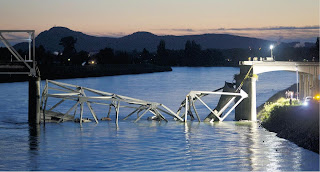Overhead clearance issues on Skagit River bridge have been recorded for decades, Washington state bridge inspectors made note of evidence that large loads were clipping the Interstate 5 span that recently collapsed into the Skagit River.
6/21/2013 By the middle of last year, an inspector identified eight different points on the bridge that had high-load damage, including some portions in which components were deformed by the impact. Then, last fall, inspectors encountered perhaps the worst damage yet: A tall vehicle travelling northbound had struck the overhead bridge structure, ripping a seven-centimetre gash in the steel, causing three portions to distort and tearing off surrounding paint, according to images and documents obtained by The Associated Press under public records law.
Even after that, state officials still didn't take precautions to prevent truckers from doing it again.
The AP found that Washington state's Department of Transportation (DOT) regularly puts detailed warnings on its trucking permits when routes are projected to encounter potentially problematic areas of low clearance. But despite the history of issues on the Skagit River bridge, the state never added warnings to permits for that span.
Federal transportation investigators believe an oversized load struck the Skagit bridge last month, causing a portion of it to collapse into the river and two vehicles with it. Nobody was seriously injured, but the failure has continued to disrupt transportation along the crucial I-5 corridor between Seattle and Vancouver.
The issues over the Skagit first started appearing in handwritten inspection notes in 1979 when an inspector noted what he deemed "minor dings" in various components, according to records reviewed by AP. A 1985 inspection specifically described "high load dings" on the first overhanging portions of the bridge that vehicles would encounter as they drive southbound - apparently the same parts that were compromised in last month's collapse. Similar notes appear in other inspections as well. In October, a bridge maintenance specialist at DOT notified another official about the large gash in the northbound portion of the bridge and the other damage that appeared to accompany it. Images show how the steel suffered under the impact, with one portion peeling back like a torn piece of paper and left pointing down the roadway. A patch of grey paint is completely gone, exposing some older green paint and the brown metal underneath.
DOT officials decided the damage wasn't severe enough to warrant an emergency, but the department worked to mend the metal and conduct a special inspection of the span.
Washington Sen. Michael Baumgartner wants DOT to take a stronger oversight role in oversized vehicle permitting to make sure such hits don't keep happening. He'd like to see the department prohibit vehicles from travelling in areas where their loads might strike overhead portions, and said officials could automatically offer alternative routes to those drivers.
Baumgartner said it was a huge risk to rely solely on the driver to safely navigate the route, especially when it may mean that the driver has to be in a specific lane. "That's just an unacceptable risk to take," Baumgartner said.
The Skagit bridge is deemed "fracture critical" because it can collapse if a single, vital component of the span is compromised. A preliminary report from the National Transportation Safety Board determined that it failed last month because the impact of the oversized load on the overhead portions of the bridge caused significant damage to those critical elements.
The driver told investigators that he felt "crowded" by another vehicle that was passing him as they arrived at the bridge, so he moved his vehicle to the right.
In order to keep traffic moving, crews opened a temporary replacement for the bridge this week, allowing motorists to cross at a slower speed.

No comments:
Post a Comment